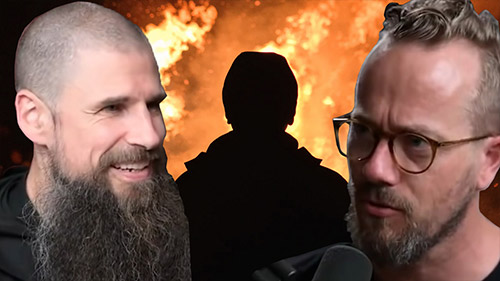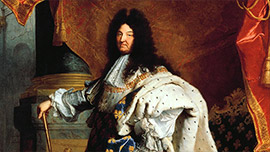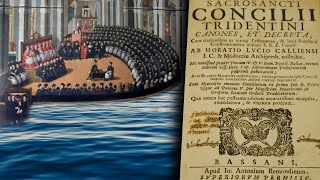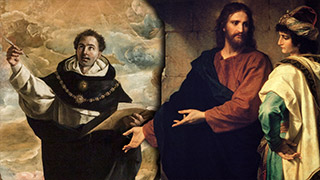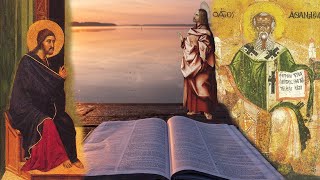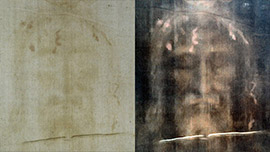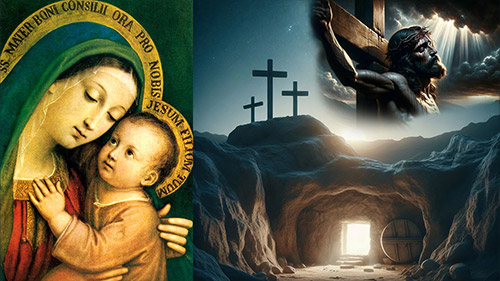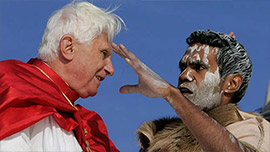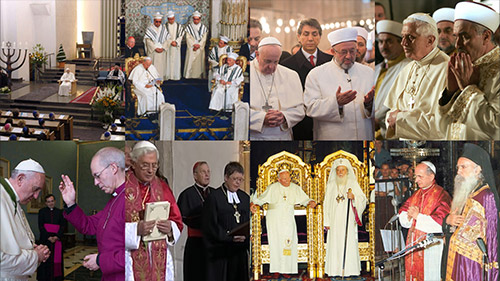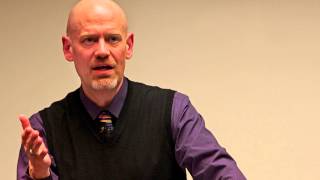 | vaticancatholic.com - English Channel |
Bible & Apologetics | Eastern ”Orthodoxy” - What Are Their True Beliefs? | Faith & Doctrine Bro. Peter Dimond This video examines and refutes one of the central positions of Eastern ‘Orthodox’ theology, namely, their claim that the light shining from Jesus during the Transfiguration was ‘uncreated’. Their position on this matter is key to Palamite Eastern ‘Orthodox’ theology and spirituality. In fact, they anathematize those who deny it. This video explains why their position is false. It refutes their position with various sources, including Eastern father Maximus the Confessor (who is one of the fathers most cited and misused by the ‘Orthodox’). This is a must-see video for those who are interested in apologetics and understanding why Eastern ‘Orthodoxy’ is not true Christianity. ARTICLE Many adherents of Eastern ‘Orthodoxy’ base their theology about God on Gregory Palamas. A major focus of Palamite theology and spirituality is the Transfiguration event and the light that was shining during that miracle on Mt. Tabor.
Palamas believed that the light which shone from Jesus’ face and His garments on Mt. Tabor was uncreated, and he condemned those who did not. His belief on this matter was connected to his false mysticism and his entire theology of essence and energies, which is filled with contradictions, heresies, and frankly outright blasphemies and nonsense. Palamism holds that the Light of Tabor was not the essence of God but also not created. It holds that it is an ‘uncreated light’ and an energy of God. A number of ‘Orthodox’ councils in the 14th century adopted Palamism and anathematized anyone who said that the Light of Tabor was created. These anathemas are incorporated into the liturgy celebrated by modern-day Eastern ‘Orthodox’. On the first Sunday of Lent, many ‘Orthodox’ read the Synodikon of ‘Orthodoxy’. It includes the following condemnations:
Well, the very position that they are anathematizing was taught by Pope St. Leo the Great, a man they claim to believe is a saint and a teacher of the true doctrine about Jesus. Before we cover that, here’s what the Greek ‘Orthodox’ liturgy says about Pope St. Leo the Great in a hymn:
Also note that in his work The Triads Gregory Palamas repeatedly claims that all the saints believed that the Light of Tabor was divine and uncreated. For example, he states:
His statement is false, just like his novel and heretical theology. It’s another example of how Palamas frequently perverts the patristric tradition. Pope St. Leo the Great directly contradicts Palamism on both the Light of Tabor and the Essence of God. What’s remarkable about the passages we will consider is the specificity with which Leo speaks about these matters. Palamism wasn’t invented until almost 1000 years after Pope St. Leo the Great. However, in God’s providence, Leo happened to speak about the nature of the Transfiguration event with remarkable precision – perhaps more precision than any other father on this matter. Also, remember that at the Council of Chalcedon, a council the Eastern ‘Orthodox’ claim to accept, it was stated that “Peter has spoken through Leo”, in regard to Leo’s position as successor of St. Peter and the pure and true doctrine he taught about Christ’s two natures in one divine person in his Tome to Flavian. Hence, even Eastern ‘Orthodox’ claim to believe that Leo the Great had special insights and was used by God to teach on the matter of the two natures of Christ in One Divine Person. Now, in Sermon 51, Leo the Great speaks about the Transfiguration. Here’s the Latin text, from J.P. Migne, Latin Fathers, volume 54, in case anyone wants to consult the original.
In this sermon Leo specifically teaches that the brightness and the glory that Peter, James and John saw on Mt. Tabor was not Jesus’ divine nature or uncreated, but rather pertained specifically to Jesus’ glorified human nature.
As we can see, Leo clearly teaches that the vision of Jesus on Tabor (and the light shining from Him) was a vision of Jesus’ glorified humanity, not His uncreated divinity. Remember, the Palamite Eastern ‘Orthodox’ anathematize this position as heresy. Note that Leo also teaches the Beatific Vision by stating that vision of the Deity itself is “reserved to eternal life for the pure in heart.” We know that Leo is correct about the Light of Tabor because Scripture tells us that Jesus’ face was shining with this light. Palamas also acknowledges that the light at the Transfiguration shone from the face of Jesus, but he doesn’t understand the implications of that admission.
Well, Jesus’ face and body were created, as even the ‘Orthodox’ admit. That’s a Christian dogma. Since the magnificent brightness was a manner in which Jesus’ face and body existed during the Transfiguration, the light was necessarily in His human nature. Even Palamas repeatedly teaches that the light was received in Jesus’ human nature and that, in his view, it is given to the human nature of justified souls.
Since the light was in Jesus’ human nature/humanity, it was necessarily created. That’s because, as the Council of Chalcedon dogmatically teaches, there is no fusion or mixture between the two natures in Christ’s one person. Rather, as the Council affirms, the property of both natures is preserved in the union of one person, with the difference between the natures at no point taken away through the union.
Hence, a human face and body cannot shine with an uncreated splendor or brightness. To state otherwise is to promote the heresy of Eutychianism, that is, to confuse or fuse the two distinct natures in the one person, which is in fact what Palamas repeatedly falls into. The confusion and mixture of the divine and human natures is a heresy that is all over Palamas’ horrible writings, and I could give many more examples of it.
Palamas seems to be completely oblivious to the Council of Chalcedon’s dogmatic definition, which declared that the two natures in Christ are not mixed or fused. Palamas teaches many heresies, but Eutychianism is one of his most prevalent. His error on the nature of the light seen in Jesus’ face at the Transfiguration is not his most egregious or obvious heresy, but it is the jumping off point for the atrocious theology he invented and many of his outrageous claims. Here’s just one example of his outrageous claims:
Indeed, to maintain that the light shining from Jesus’ face on Tabor was uncreated is not only a theological error that leads to Eutychianism if fully embraced, but it is to deny the reality of the transfiguration of Jesus’ body. μετεμορφώθη is the Greek word used in Matthew 17:2 for the transfiguration. It means that Jesus’ form or figure (of course referring to His external human appearance) was changed, transformed, metamorphosed. Well, a human figure cannot change into an uncreated divine form. That would be again to confuse the natures. But Jesus’ typical human figure or appearance can be changed into a glorified human form, which is what happened during the miracle. St. Thomas Aquinas also points out that it was due to a special dispensation that “the glory of His soul did not overflow into His body from the first moment of Christ's conception” (Summa Theologiae, Pt. III, Q. 45 A. 2). But Peter, James and John received a glimpse of His glorified human body during the miracle. To say, as the Palamites do, that what Peter, James and John saw was an uncreated divine light that always existed is to deny that Jesus’ human figure or appearance really changed into another human figure or appearance. It is thus to deny that there really was a transfiguration. This article is not about what all the fathers said with regard to the Transfiguration. It’s primarily about what Pope St. Leo the Great and Maximus the Confessor taught. However, I will note that there are other fathers, including Eastern fathers, who indicate that the light witnessed on Tabor was not uncreated but rather an aspect of Jesus’ glorified human form. There are also quotes that Palamites bring forward from saints and fathers as if they favor their view on the vision of the Transfiguration, but those quotes are not to the point. They could be understood as referring to the Transfiguration miracle revealing the identity of the Son, who is Light from Light, true God from true God, rather than addressing with specificity the nature of what the Apostles saw in Jesus’ face and body. In fact, Leo’s passage is perhaps the most precise treatment of this matter among all the fathers, and it’s notable that he emphasizes that the vision “specifically pertains to the nature of His assumed humanity.” Of course no Church father taught the outrageously heretical Palamite theology, which is filled with heresies, including the false teaching that posits a real distinction in God between essence and ‘uncreated energies’. That false theology also holds that some uncreated things begin to exist, which is heretical, anti-Christian nonsense contradicted by the councils and fathers.
Now, even though the brightness and glory that Peter, James and John saw on Mt. Tabor specifically pertained to Jesus’ glorified human nature (and was therefore created), as Pope St. Leo the Great correctly teaches, the splendor was, as St. Thomas Aquinas also points out, derived from His Godhead and from His glorified human soul.
In conjunction with the voice from the cloud saying, ‘This is My Beloved Son’ (Mt. 17:5), the miraculous brightness and glory that shone forth from Jesus’ body during the Transfiguration was a revelation about who Jesus is.
It revealed to the chosen disciples that within Jesus was a glory that transcended the Earth – a glory shining in His body and derived from His divinity through His glorified soul. Jesus will also communicate glory to the bodies of the just in the Resurrection, as many saints teach based on:
Indeed, in St. John of Damascus’ Homily on the Transfiguration, even though there is a focus on the Transfiguration as a further revelation of Jesus’ divine identity, he emphasizes that the two natures in Christ remain unmixed and unconfused in the sublime union of one person.
Since Jesus is one Divine person, the brightness with which He was shining on Tabor in front of Peter, James and John was indeed the splendor of God the Son; but it was the splendor of God the Son in His glorified human form. And if you decide to engage in a precise analysis of the face and the light shining in that face on Tabor, it must be held to retain the proper structure of the created and human nature, as Leo the great correctly teaches. It is not uncreated. Hence, the disastrous error Palamas made, spurred on by false mysticism, was to attribute a quality proper only to the divine nature, namely being uncreated, to what specifically pertains to human nature (i.e. to Jesus’ shining human face). As we’ve seen, this leads to various heresies and actually idolatry. MAXIMUS DEBUNKS PALAMISM ON THE TRANSFIGURATION LIGHT Also consider what Eastern father Maximus the Confessor says on this issue. In various passages he teaches, just as Leo the Great did, that the light shining from Jesus’ face on Tabor was created. These passages are extremely significant because Maximus the Confessor is one of the Eastern fathers most frequently cited, or rather abused and misused, by Palamites.
Here Maximus the Confessor teaches that the light which appeared to their senses on the mountain was a “symbol” (σύμβολον) of the unseen hiddenness of God, and obviously therefore it was not the uncreated divinity itself. Other passages from Maximus in the same work confirm this meaning. For instance:
Note, according to Maximus, symbols that fall within the range of our senses are creations. Well, we already saw that the light shining from Jesus’ face was, according to the same Maximus in the same work, a symbol that appeared to their senses. It was therefore an aspect of Jesus’ created, yet glorified, human nature, as Leo the Great teaches. This is further confirmed when Maximus explains how the Transfiguration event was a symbol of both the negative and affirmative modes of mystical theology. Maximus teaches that when the Apostles were overwhelmed by the vision, analogous to how a ray of light can overwhelm the activity of the eyes, it formed within them an understanding that God’s essence, the Godhead, is ineffable. It’s beyond comprehension. In that way the Transfiguration event formed within them the negative or first mode of mystical theology, according to Maximus. With regard to the second or affirmative mode of mystical theology, he says this:
Note carefully that the second or affirmative mode of mystical theology deals with created effects. He then says:
Here Maximus teaches that the same light – the light that shone from Jesus’ face – formed within them the affirmative mode of theology (a mode dealing with effects and the magnificence of creation). His meaning is again clearly that the light is created, not uncreated. He likewise says that the shining garments of the Lord signified the visible objects of creation, which would not be the case if they were shining with uncreated light. Maximus’ repeated teaching that the light was a created symbol of the divinity, not the uncreated divinity itself, is totally contrary to (and in fact anathema to) Palamite Eastern ‘Orthodoxy’. It really is remarkable that Eastern father Maximus the Confessor so clearly contradicts, and in fact debunks, the false Palamite theology on their central claim about the light of Tabor. It’s another good example of how false their claims are in general. They take advantage of the lack of familiarity their listeners have with these deeper matters of theology and history, leading them into a false religion with false claims about the fathers and the Church. Also note that Maximus says the mode concerned with activity or energy is grounded in creation. That’s because in many contexts when the fathers refer to energies, they are referring to the created effects of God’s activity. Those effects, which are plural, tell us something about what God truly has and what He truly is (such as good, powerful, wise, etc.) But those effects or energies do not define His essence in a comprehensive or perfect way. Yet, so many Palamite heretics misunderstand and misuse references to energies among the fathers. Hence, there is a real distinction between God’s essence and His energies, when energies are understood as referring to created effects of His activity. But there is no real distinction in God Himself between the divine essence and supposedly ‘uncreated energies’, as the Palamites heretically say. Now, here is another passage of Pope St. Leo the Great that deals with divine simplicity. In it he teaches that all the attributes predicated of God are, in Him, the Divine Essence. This also directly contradicts the Eastern ‘Orthodox’ Palamite heresy, which holds that in God the Divine Essence is not the attributes or the “energies”.
As we can see, Leo teaches that every attribute predicated of God is, in Him, really His essence. This is the true doctrine of the Church, which was also formally affirmed in the letters of Pope St. Agatho (dogmatically confirmed by Constantinople III), as we prove in our other videos. Leo’s statement is directly contrary to the Palamite heresy, which contradicts divine simplicity. For those who don’t know, divine simplicity refers to the truth that God is not in any way composite or composed of parts. It is a dogma of the Christian Church, taught by the fathers and affirmed by the councils. Leo correctly teaches that this truth about the Divine Essence follows from the fact that God is in need of no participation. If in God goodness or power or another attribute is really distinct from the Divine Essence, as the Palamites say, then only the composite of essence + goodness or essence + power would be God. But that’s heretical. God is simple, and needs no participation, as Cyril’s Third Letter to Nestorius, approved by Ephesus, also teaches. That’s why God is said to be His attributes. He is said to be love, wisdom, power, etc.
As we can see, God is His attributes. Now, in the following quote Gregory Palamas emphatically denies that God’s attributes are His essence, and in his ignorance and blindness he insults true Christians like Leo the Great (and the Third Council of Constantinople) who taught this Christian dogma.
His claim is false, as we’ve shown. Palamas also teaches the heresy that God is composite when he declares that the Divine Essence gathers the powers/attributes into unity.
That is to teach the heresy that God is composite because it means that the divine powers or attributes are not the one God in themselves but are only made to be one in God by another reality that unites them, namely, the Divine Essence. But what is united to one thing by another reality, and isn’t that one thing in itself, is a component or a part of that other thing. Palamas’ doctrine here would mean that God is a composite of essence and energies, which is heresy. We could give many other examples of Palamas teaching various heresies and the heresy that God is composite. What Leo the Great teaches above about how everything predicated of God is, in Him, the Divine Essence is exactly what St. Thomas Aquinas and the Church would later teach about divine simplicity. See Pope St. Agatho’s letters approved by Constantinople III, etc. It’s also interesting that in the 5th century Leo says that God’s particular property to is exist eternally, which is what St. Thomas later would describe as God’s essence being the same as His existence (i.e. God is 'Subsisting Existence Itself').
Also remember that the Palamite Eastern ‘Orthodoxy’ anathematizes the aforementioned teaching of Leo the Great, a man they claim to venerate as a saint. These facts are just more proof that Eastern ‘Orthodoxy’ is not the true Christian faith. It rejects the truth about God, among other things. To be a true Christian and be saved one must be a traditional Catholic. We will close this article with a question and answer that highlights a key point of this matter. Q. Why couldn't Jesus's divine nature shine through his human nature and still remain as two separate natures? A. The brightness of a human face does not have existence in itself but only as a quality of the human/created face. It's an accident. It exists in another, not in itself. Thus, if you say that the light was divine and uncreated, then the light had its own eternal self-existence. In that case Jesus’ face would not have even been shining with it. Rather, the Apostles would have simply seen the unveiled divinity but not Jesus’ human form transfigured. But the Scriptures are clear that Jesus’ human face was transfigured and was really shining with this light. The light was a quality of Jesus’ human face – thus it had to have been created. It was also visible to bodily eyes – thus it had to have been created (as Maximus correctly teaches). Even Palamas, condemning himself, admits that the light was really in Jesus’ face and in His human nature, but he still teaches that it was uncreated (thus falling into Eutychianism). That’s covered in the article/video. Copyright © 2021 Most Holy Family Monastery |
Catholic vs. “Orthodox” On The Transfiguration Light (Leo, Maximus)
September 28, 2021
SHOW MORE
Latest News
The moment an Israeli strike flattened a large residential building in Beirut - video
Babies among 23 found dead in Israeli attack on "predominantly Christian area" in Lebanon - video
"Mentalist magician" Oz Pearlman stuns Mike Tyson by burning initials of his friend on his fingers - video
Canadian school board defends policy to allow boys in girls’ change rooms despite parents’ protests
Rescued raven feeds her friends with her own food - video


